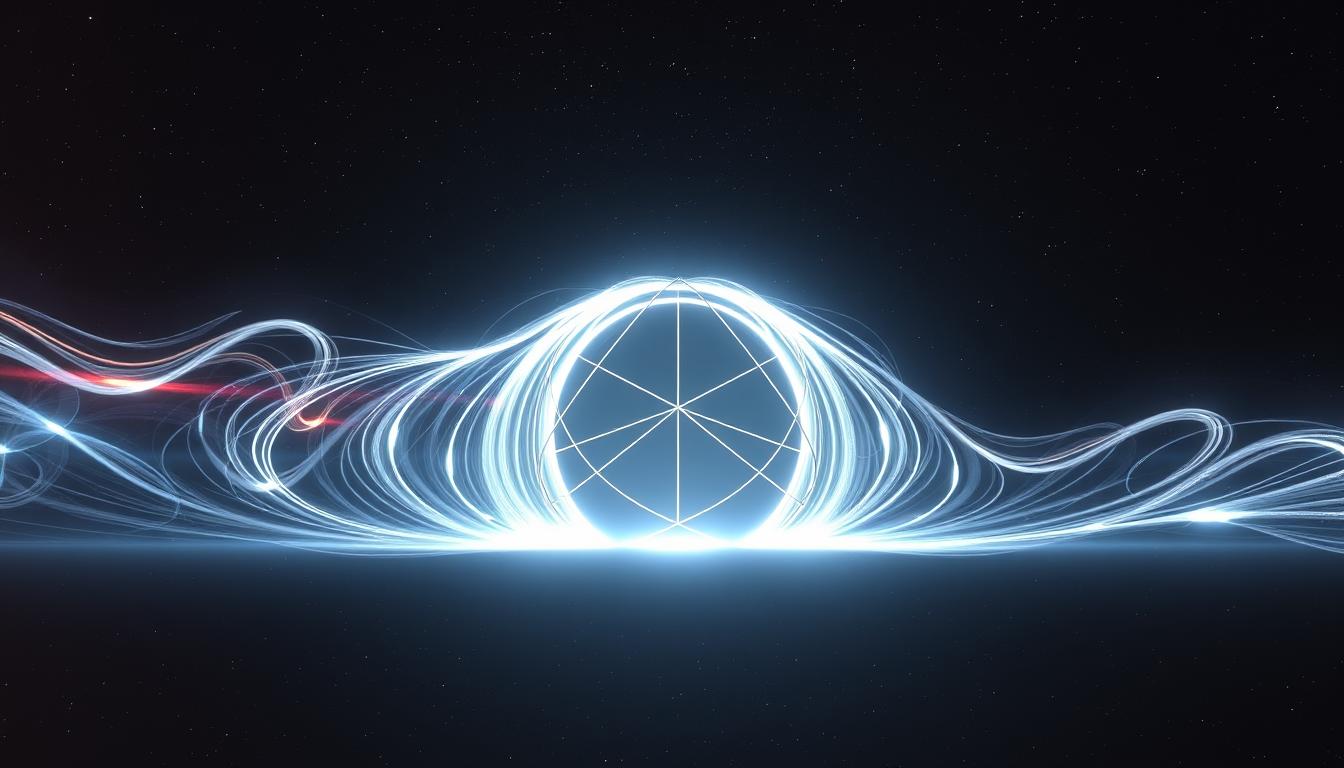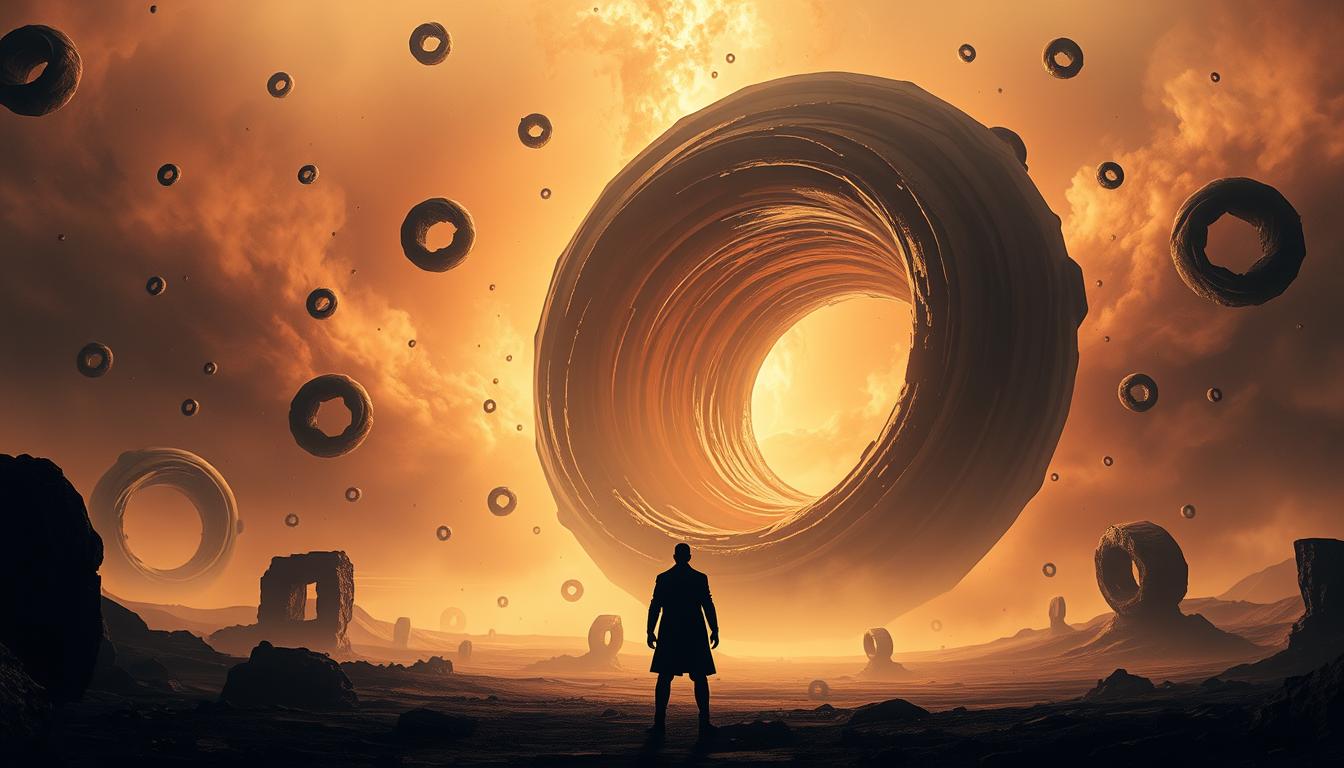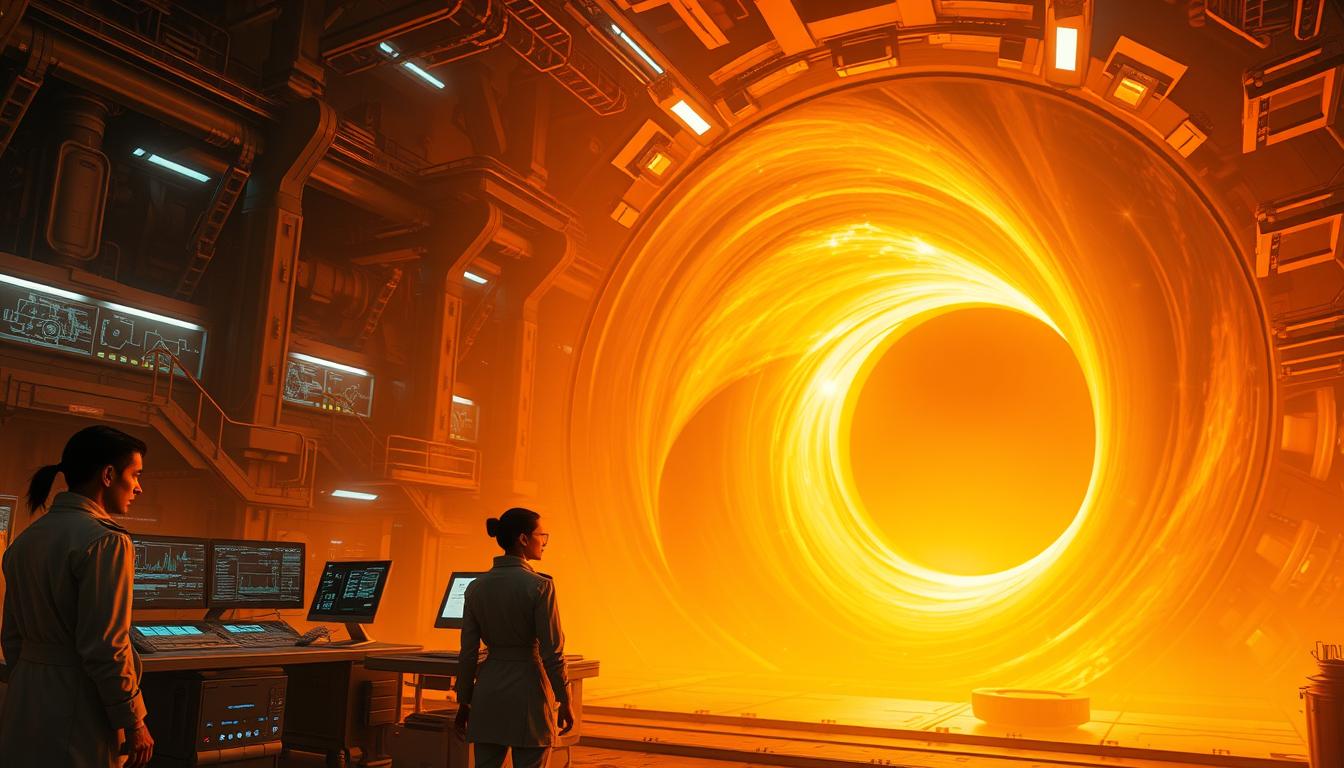If you fold the space like a sheet of paper, two parts of the very opposite side of the universe would touch each other. That’s the image behind the Einstein Rosen Bridge, the wormhole theory as many of us know it. Imagine taking a shortcut across the universe? For those reading this for the first time, it may sound like a wild theory, but it’s supported by Albert Einstein’s and Nathan Rosen’s math written in 1935. The essence was looking at what Einstein’s equations may allow if they are pushed to extremes.
Check this article out, too: What is Big Rip Theory: Will the Universe Expand Forever?
For most of us, the words “wormhole” or “Einstein Rosen Bridge” are about starships jumping across galaxies. But the actual idea is stranger. Spacetime isn’t fixed, it can warp, stretch, and loop back on itself as a bridge between faraway points. Cosmic tunnels, as predicted by general relativity, could theoretically connect distant regions of spacetime.
The idea first came in 1935 (when Einstein and Rosen proved it) and that’s when the concept was first introduced, called Einstein Rosen Bridge. It started as purely mathematical, but people became intrigued, so decades of research have given us a lot more. It’s still purely mathematical and nothing more than a theory, but we know more than we did in 1935. We’ll cover the simple picture (fabric, tunnels, and maps), look at the weird physics that might keep a wormhole open, and point out why real scientists treat these ideas as both promising and painfully problematic.

Introduction to Einstein Rosen Bridge and Wormholes
The einstein rosen bridge is a theoretical shortcut in space and time, a tunnel the math allows if you stretch Einstein’s ideas far enough. Think of it as folding a map for distant places to touch. Instead of paper, you’re folding spacetime itself. Wormholes could make interstellar travel as simple as stepping through a door. The original Einstein Rosen Bridge is a non-traversable wormhole, meaning, it can’t stay open. After decades of more mathematical crunching, we also came to the idea that there could be traversable wormholes, the ones that can remain open to let something through them. But we have no proof of either.
Unlike black holes, which trap everything inside, these structures might let you cross galaxies in moments. That’s why, from the beginning in 1935, scientists and everyone else wanted to look at this, research it deeply. If we can make it happen (we are far from that now), imagine the depths of the universe we can see. Google made a tiny, atomic-level wormhole a few years back in one of its experiments. Good start, but it’s nowhere close to being usable.
What is a Wormhole, The Einstein Rosen Bridge Concept
A wormhole is best understood as a shortcut through the universe’s shape. Rather than moving across the familiar three-dimensional space, imagine you could step into a tunnel that connects two far-flung locations directly. A tunnel with two mouths connected by a narrow throat. One mouth could be near Earth; the other, near a star light-years away. In theory, traversable wormholes stay open long enough for matter to pass through, unlike Schwarzschild wormholes, which collapse instantly.
The term “wormhole” is a vivid metaphor, but in physics, the idea is more precise. It’s a solution to Einstein’s general relativity equations where spacetime forms a bridge between distant regions. The phrase Einstein Rosen Bridge specifically names the bridge-like solution first highlighted by Albert Einstein and Nathan Rosen.
That solution doesn’t automatically promise a convenient travel gate. Some versions pinch off too quickly or lead to regions that are physically hostile. So, one of the biggest questions is what conditions would keep such a bridge open? Could light or a signal squeeze through? Are there versions that let people, or at least information, pass safely? The clean math gives the credibility for it, but the physics of keeping a tunnel open and the energy we need make it look impossible.
Historical Background to the 1935 paper
In 1935, Albert Einstein and his collaborator Nathan Rosen were working on the equations of general relativity and the mathematical description of particles. While working through these puzzles, they found a particular solution that looked like two identical regions of spacetime joined by a throat. A bridge. They presented this as a formal mathematical structure rather than a fanciful portal. Initially, the Einstein-Rosen solution was a technical observation: an elegant, symmetric construct that fit the equations but raised practical concerns. Over decades, physicists revisited the bridge to test whether such a geometry could be stable, traversable, or linked to other ideas like black holes.
The Science Behind the Einstein-Rosen Bridge
To understand how the Einstein-Rosen Bridge works, we need to examine the laws that enable it to exist on paper. Einstein’s theory of general relativity tells us that mass and energy warp the fabric of spacetime. Instead of gravity being a mysterious pulling force, it’s just matter bending geometry and everything else rolling along those curves. When that curvature becomes extreme enough, space can theoretically fold back on itself, creating a tunnel. That’s the essence of the bridge.
General Relativity and Wormholes
Einstein’s general relativity is the rulebook describing how space and time react to energy. Picture spacetime as a flexible rubber sheet. Put a heavy ball in the middle, a planet, and the sheet dips, curving around it. Smaller marbles roll toward the ball because they’re following those curves. If you twist the sheet enough, those two distant regions could touch. It creates a “throat” connecting those regions. Einstein’s equations predict that these structures could exist, but it’s not easy to keep them open. They would require extreme conditions to stay open. The Einstein Rosen Bridge was the first formal example of such a throat, connecting two identical universes or two distant parts of one universe. However, the bridge wasn’t stable, the tunnel collapsed too fast for anything to pass through. Later physicists, like Kip Thorne, explored ways it could stay open using exotic matter (stuff with negative energy density), but so far it remains a theoretical dream.
Types of Wormholes
Wormholes are of different types. Some you can theoretically travel through, and some close before anything gets halfway. The differences depend on how spacetime behaves around the tunnel’s mouth. These ideas live mostly in equations and thought experiments, and they show how flexible Einstein’s geometry can be. There are three (or four) main types of wormholes scientists generally look at.
Schwarzschild Wormholes
The Schwarzschild wormhole is the earliest, simplest version, the very one Einstein and Rosen described in 1935. It’s born from the mathematics of a non‑rotating black hole, also known as a Schwarzschild black hole. In this solution, two separate universes share a single event horizon, linked by a bridge‑like throat, but the throat exists for a moment. Picture a tunnel that collapses faster than you can say “black hole.” That’s a Schwarzschild wormhole. It’s a non-traversable bridge. Even light can’t go through it. Think of it less like a tunnel and more like a bubble that pops the moment you touch it. Yet this model laid the groundwork for all later wormhole theories. It taught physicists that relativity’s equations can produce connected spaces.
Traversable vs Non-Traversable Wormholes
A traversable wormhole is the dream version: stable, open, and safe enough to let light, information, or maybe even people pass through. In math, it means both ends of the tunnel stay connected without collapsing. Keeping such a tunnel open requires what’s known as exotic matter. Material with negative energy density that pushes spacetime outward instead of pulling it in. No one’s found that stuff in nature yet.
On the flip side, non‑traversable wormholes are purely theoretical bridges that collapse instantly or exist behind event horizons, making them impossible to cross. The original Einstein Rosen Bridge falls into this category: elegant on paper, but useless for travel because gravity snaps it shut faster than light can move.
Lorentzian and Euclidean Wormholes
These two sound intimidating, but they’re just different mathematical perspectives on spacetime. Lorentzian wormholes use the usual spacetime metric we experience, one dimension of time, three of space. They represent “real‑time” bridges that could, in theory, connect distant points or universes. These are the kind of wormholes most discussions focus on when talking about travel or communication (traversable wormholes).
Euclidean wormholes, on the other hand, live in imaginary time, a mathematical trick where time behaves like another spatial direction. They often appear in quantum gravity studies and cosmology, helping physicists model early‑universe processes or vacuum fluctuations (non-traversable wormholes).
At the quantum scale, spacetime might foam with tiny Lorentzian wormholes, flickering in and out of existence at the Planck length. Meanwhile, Euclidean “instantons” (theoretical shortcuts through imaginary time) appear in some quantum gravity theories.
The Role of Exotic Matter in Wormholes
Most wormhole solutions from Einstein’s equations want to pinch closed immediately; gravity pulls everything shut. To keep a throat open, you need something that does the opposite of normal matter: it should push outward on spacetime, creating a pressure that resists collapse. We don’t know if there is a matter that does this; we can’t detect it. Physicists call such hypothetical stuff “exotic matter.” It isn’t a single known ingredient on the periodic table. Instead, it’s a label for forms of energy that behave oddly, like having negative energy density. Without some form of exotic matter, an einstein rosen bridge stays a neat math trick rather than a possible shortcut. That puts exotic matter at the center stage in any conversation about traversable wormholes.
What Is Exotic Matter?
In regular matter, the stuff that makes up planets, people, and pancakes, energy density is positive: squeeze more mass into a region and gravity (the ball and sheet metaphor) goes deeper and deeper. Exotic matter would have regions of negative energy density. That means, in a loose sense, it could repel rather than attract (if positive attracts, negative would repel, right?). It would create spacetime curvature opposite to what ordinary matter does.
For a human-sized wormhole, you’d need exotic matter equivalent to Jupiter’s mass. That’s why physicists like Matt Visser proposed “polyhedral” designs, reducing the requirement by shaping wormholes like geometric cages. In tiny setups, like the Casimir effect between closely spaced metal plates, measurable negative energy densities can appear due to quantum field fluctuations. But scaling that up to hold open a wormhole throat is a different beast.
Stabilizing Wormholes
Knowing the fundamentals of a wormhole and opening one are much more different than stabilizing a wormhole. Imagine; you find a way to actually create a real-life size wormhole and somehow manage to keep that stable. According to our current understanding of physics, we don’t even know if the material that can keep a wormhole open is real and can be found. We’re looking at experiments like mimicking exotic field properties. One common picture is the “thin shell” model: a carefully placed shell of negative energy wrapped around the throat, tuned so tidal forces are gentle and the geometry remains smooth.
Wormholes and Black Holes
The effects of black holes and wormholes are extremely different, but they both warp spacetime. A black hole traps everything inside its event horizon. When something passes the event horizon, there is no leaving; it’s trapped in a singularity. Wormholes, on the other hand, if they can stay open long enough, can be a door to somewhere else (theoretically). Both are built from the same Einsteinian equations.
Connections and Distinctions
Imagine spacetime as a vast rubber sheet. Drop a massive object on it like a star, and it dents the surface. That dent is gravity. Now, make the dent so deep that it pokes through to the other side. It’s Einstein Rosen bridge.
A black hole, meanwhile, is what happens when the dent just keeps going until it tears through the fabric, creating a bottomless pit. They have connections in the sense that they both are created because of gravity’s movements. But a wormhole has two openings, whereas a black hole has only one, the entrance.

Using Einstein Rosen Bridge or Wormholes for Space and Time Travel: Possible?
As I said before, Einstein Rosen Bridge and the traditional sci-fi wormholes are two different things. Einstein Rosen bridge is a type of wormhole that can’t stay open, it’s a Non-Traversable wormhole. So, with those, space or time travel isn’t possible. With traversable wormholes, it’s a different story. Keep in mind that both types are only theories; we can’t prove they exist.
However, what physics and mathematics tell us is that if we can find a way to stabilize the wormhole, have enough energy, and keep it open, the wormholes have an entry and an exit. This means they either open at another time or place. Or both. Theoretically, they also bypass light-speed limits. Another massive reason why it’s impossible to have a real, functioning wormhole.
Energy and Stability Hurdles
Think of a wormhole like a bridge built across a canyon. Ordinary bridges need steel and concrete; wormholes need energy configured in a very peculiar way. The biggest problem isn’t making the tunnel, it’s keeping it from collapsing the moment something tries to use it. Did you ever play that game where you have to build bridges and they need to stand when a car or truck passes? Yes, it’s like that.
That maintenance would require exotic matter with negative energy density to push outward against gravity’s natural squeeze. In everyday physics, energy is positive: pack more mass into a spot and gravity digs a deeper pit. For a traversable wormhole, you need pockets where energy dips below the usual baseline. Kip Thorne calculated how much exotic matter we’d need to stabilize a wormhole. Stabilizing a 1-meter wormhole needs exotic matter with negative energy equivalent to Jupiter’s mass. Even then, radiation blueshift at the throat would vaporize anything passing through.
Time Travel Through Wormholes
Here’s where the story gets juicy. If one mouth of a traversable wormhole moves relative to the other, time will pass differently at each mouth thanks to time dilation. Reconnect them, and you’ve created a path where one entrance is younger or older than the other. That’s the recipe for a time machine in many thought experiments: travel through the wormhole and emerge at a time that, from the outside, looks like the past. Physicists take these possibilities seriously, not because they want to build time machines, but because they test the consistency of our laws.
Theoretical Possibilities
Despite the obstacles, theorists haven’t given up inventing clever workarounds. Some proposals shrink the goal: instead of transporting people, maybe tiny amounts of information — quantum bits — could tunnel through brief, microscopic wormholes, creating connections between entanglement and geometry. That’s what Google tried and managed to do.
Other approaches look to quantum gravity frameworks (like string theory or loop quantum gravity), where the usual rules might relax and open new windows for stable tunnels at the Planck scale. There are also semi‑classical ideas where naturally occurring quantum fluctuations create fleeting, microscopic bridges that transmit correlations without permitting macroscopic travel. These tiny wormholes wouldn’t help you reach Proxima Centauri next Tuesday, but they could reveal deep ties between space, time, and information.

Conclusion
Wormholes have always been the love of science fiction because of the possibilities. In reality, though, it’s much different. Einstein Rosen Bridge theory is the key to the wormhole idea and the original theory published in 1935 is not even traversable. It collapses before anything can get into it. However, with research and dedication, scientists have managed to create mathematics and physics behind a traversable wormhole – a wormhole you can pass through, with it closing down. It happens with something called exotic matter. We’ve never seen this matter, and it doesn’t exist in our universe (as far as we know and see), so it’s only a theory that something like this should exist. Kind of like dark matter and how dark matter was found.
With traversable wormholes, because it is faster than the speed of light, the end that you exit is in another timeline than the one you entered. It could open up the time travel possibility. All of this, all types of possible wormholes, though, are only in theory. We don’t know if it’s really possible to open these in real life. Google tried to do this on the sub-atomic, quantum level, and it worked. They did open a wormhole very briefly, but that’s pretty much it. We’re still trying to understand the full physics behind it.
FAQ
What exactly is a wormhole?
A wormhole is a hypothetical tunnel in spacetime that could connect two distant points in the universe. Think of it like a cosmic shortcut; it bends space and time to link separate regions.
How does the Einstein-Rosen bridge relate to wormholes?
The Einstein-Rosen bridge is a specific type of wormhole that general relativity predicts. It forms when a two points connects to each other in spacetime, though it’s unstable and collapses quickly.
Could wormholes allow faster-than-light travel?
Theoretically, yes. Traversable wormholes might let you cross vast cosmic distances instantly. But they’d require exotic matter with negative energy to stay open, which hasn’t been proven to exist.
Are wormholes and black holes the same thing?
No. Black holes pull matter in irreversibly, while wormholes could (in theory) let you pass through. However, some wormholes might form from black hole connections.
Has a wormhole ever been observed?
Not yet. Wormholes remain a mathematical prediction. Detecting one would require spotting gravitational anomalies or light bending in unexplained ways.